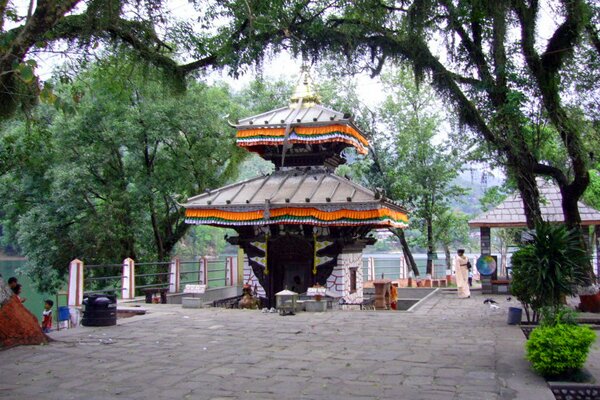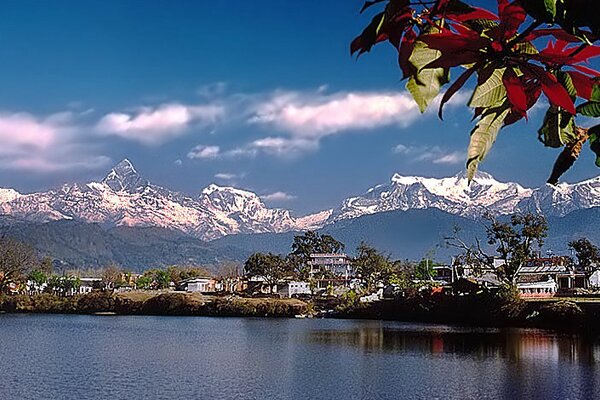Pokhara
The Lake City
General Information
Other Name: -, District: Gandaki , State: Western Region (Pashchimanchal) , Nepal
Area: 0
Languages Spoken: Nepalese, Newari and Maithali
Long Distance Code: -
Importance: -
Best Time to Visit: March to October and -
International Access: -
Description
The magnificent city is located west of Kathmandu.It is the third largest city after Kathmandu and Biratnagar.Pokhara is often called the enchanting Himalayan valley with a heart of major actions and adventures. It is also one of the most popular tourist destinations in Nepal.Surrounded by beautiful snow-caped mountains with a magnificent lake of crystal-clear pure Himalayan water; the Pokhra is a dream come true.Among the attractions, nothing is as majestic as the Fewa (or Phewa) Lake. The lake is 1.5-kilometer long and second largest in Nepal. Fewa Lake offers an excellent view of the mountains and their reflections in the water.Most interesting is the old centre in the north of the city (purano bazar) where still many old shops and warehouses in the Newari style can be found.Temples worth visiting in the older part of town are Bindhyabasini temple and Bhimsen temple.Location
198 km west of Kathmandu.Climate
The climate is sub-tropical but due to the elevation the temperatures are moderate: the summer temperatures average between 25 - 35°C, in winter around 5 - 15°C.
 The Annapurna Regional Museum is a natural history museum devoted to the Annapurna region and the Annapurna Conservation Area Project.Among its highlights is an unusually comprehensive butterfly collection.
The Annapurna Regional Museum is a natural history museum devoted to the Annapurna region and the Annapurna Conservation Area Project.Among its highlights is an unusually comprehensive butterfly collection.  Founded in the 17th century, the Bindhya Basini Temple is sacred to Durga, the warlike incarnation of Parvati, worshipped here in the form of a saligram.
Founded in the 17th century, the Bindhya Basini Temple is sacred to Durga, the warlike incarnation of Parvati, worshipped here in the form of a saligram.  The Barahi Temple is the most important monument in Pokhara. Built almost in the Center of Phewa Lake, this two-storied pagoda is dedicated to the boar manifestation of Ajima, the protester deity representing the female force Shakti.
The Barahi Temple is the most important monument in Pokhara. Built almost in the Center of Phewa Lake, this two-storied pagoda is dedicated to the boar manifestation of Ajima, the protester deity representing the female force Shakti. Davis Fall is the most famous water fall in Pokhara, which comes to its gushing best just before disappearing underground.
Davis Fall is the most famous water fall in Pokhara, which comes to its gushing best just before disappearing underground.
 Lakeside, on the east shore of Lake Phewa, caters specifically for tourists.Even so Lakeside is genuinely picturesque, with a relaxing, easy-going atmosphere particularly appreciated by exhausted trekkers.
Lakeside, on the east shore of Lake Phewa, caters specifically for tourists.Even so Lakeside is genuinely picturesque, with a relaxing, easy-going atmosphere particularly appreciated by exhausted trekkers. The Himalaya skyline is dominated by Mt Machhapuchhare (''Fish Tail'' in Nepali) - at 6997m, it`s actually one of the smaller peaks of the Annapurna Range, but it looks taller as it`s closer to Pokhara.
The Himalaya skyline is dominated by Mt Machhapuchhare (''Fish Tail'' in Nepali) - at 6997m, it`s actually one of the smaller peaks of the Annapurna Range, but it looks taller as it`s closer to Pokhara. Phewa lake, the second largest lake in the kingdom, roughly measuring 1.5 km by 4 km, is the center of all attractions in Pokhara. The enchanting lake is an idyllic playground. Brightly painted wooden boats and sailboats can be rented on reasonable cost around lakeside. The lake is neither deep (roughly 47 meters at most) nor particulary clean, but the water is warm and swimming is pleasant if you don''''t think about the probable pollution. The eastern shoreline of the lake, popularly known as Lakeside or Baidam, consists of seemingly endless strip of lodges, restaurants, bookshops and souvenir shops. One of the fascinating parts of lakeside is the splendid view of the mountains, especially when the still water reflects the peaks, creating a double image.
Phewa lake, the second largest lake in the kingdom, roughly measuring 1.5 km by 4 km, is the center of all attractions in Pokhara. The enchanting lake is an idyllic playground. Brightly painted wooden boats and sailboats can be rented on reasonable cost around lakeside. The lake is neither deep (roughly 47 meters at most) nor particulary clean, but the water is warm and swimming is pleasant if you don''''t think about the probable pollution. The eastern shoreline of the lake, popularly known as Lakeside or Baidam, consists of seemingly endless strip of lodges, restaurants, bookshops and souvenir shops. One of the fascinating parts of lakeside is the splendid view of the mountains, especially when the still water reflects the peaks, creating a double image.Remarks: Second-largest lake in Nepal.
Golden Triangle Tour of Nepal / NEP-001 (8 Days / 7 Nights)
Kathmandu-Chitwan-Pokhara-Kathmandu
This eight-day comprehensive tour of Nepal includes the enchanting Kathmandu valley visiting its three principal cities of Kathmandu, Patan & Bhaktapur along with other widely-known areas of interest such as the Royal Chitwan National park (932 sq. km) in south central Nepal for a wildlife experience and combining it with a visit to the scenic Pokhara valley in mid west Nepal governed in the north by the majestic Annapurna massif, a glittering wall of ice rising above the tranquil lakes of this beautiful valley.
Detailed Itinerary
Day 1 : Kathmandu
Day 2 : Kathmandu
Day 3 : Kathmandu
Day 4 : Kathmandu-Chitwan
Day 5 : Chitwan
Day 6 : Chitwan-Pokhara
Day 7 : Pokhara
Day 8 : Pokhara-Kathmandu
Kathmandu-Chitwan-Pokhara-Kathmandu
This eight-day comprehensive tour of Nepal includes the enchanting Kathmandu valley visiting its three principal cities of Kathmandu, Patan & Bhaktapur along with other widely-known areas of interest such as the Royal Chitwan National park (932 sq. km) in south central Nepal for a wildlife experience and combining it with a visit to the scenic Pokhara valley in mid west Nepal governed in the north by the majestic Annapurna massif, a glittering wall of ice rising above the tranquil lakes of this beautiful valley.
Detailed Itinerary
Day 1 : Kathmandu
Day 2 : Kathmandu
Day 3 : Kathmandu
Day 4 : Kathmandu-Chitwan
Day 5 : Chitwan
Day 6 : Chitwan-Pokhara
Day 7 : Pokhara
Day 8 : Pokhara-Kathmandu
Scenic Tour / NEP-012 (6 Days / 5 Nights)
Kathmandu-Pokhara-Kathmandu-Pokhara-Kathmandu
.
Detailed Itinerary
Day 1 : Kathmandu
Day 2 : Kathmandu
Day 3 : Kathmandu-Pokhara
Day 4 : Pokhara
Day 5 : Kathmandu-Pokhara
Day 6 : Kathmandu
Kathmandu-Pokhara-Kathmandu-Pokhara-Kathmandu
.
Detailed Itinerary
Day 1 : Kathmandu
Day 2 : Kathmandu
Day 3 : Kathmandu-Pokhara
Day 4 : Pokhara
Day 5 : Kathmandu-Pokhara
Day 6 : Kathmandu
Abode of Himalayas / NEP-014 (7 Days / 6 Nights)
Kathmandu-Pokhara-Kathmandu-Nagarkot-Kathmandu
.
Detailed Itinerary
Day 1 : Kathmandu
Day 2 : Kathmandu-Pokhara
Day 3 : Pokhara
Day 4 : Pokhara-Kathmandu
Day 5 : Kathmandu-Nagarkot
Day 6 : Nagarkot-Kathmandu
Day 7 : Kathmandu
Kathmandu-Pokhara-Kathmandu-Nagarkot-Kathmandu
.
Detailed Itinerary
Day 1 : Kathmandu
Day 2 : Kathmandu-Pokhara
Day 3 : Pokhara
Day 4 : Pokhara-Kathmandu
Day 5 : Kathmandu-Nagarkot
Day 6 : Nagarkot-Kathmandu
Day 7 : Kathmandu
Adventure Tour II / NEP-016 (8 Days / 7 Nights)
Kathmandu-Chitwan-Pokhara-Kathmandu
.
Detailed Itinerary
Day 1 : Kathmandu
Day 2 : Kathmandu
Day 3 : Kathmandu-Chitwan
Day 4 : Chitwan
Day 5 : Chitwan-Pokhara
Day 6 : Pokhara
Day 7 : Pokhara-Kathmandu
Day 8 : Kathmandu
Kathmandu-Chitwan-Pokhara-Kathmandu
.
Detailed Itinerary
Day 1 : Kathmandu
Day 2 : Kathmandu
Day 3 : Kathmandu-Chitwan
Day 4 : Chitwan
Day 5 : Chitwan-Pokhara
Day 6 : Pokhara
Day 7 : Pokhara-Kathmandu
Day 8 : Kathmandu
Unforgettable Himalayas Frontier / NEP-017 (8 Days / 7 Nights)
Kathmandu-Pokhara-Jomsom-Pokhara-Kathmandu
.
Detailed Itinerary
Day 1 : Kathmandu
Day 2 : Kathmandu
Day 3 : Kathmandu-Pokhara
Day 4 : Pokhara-Jomsom
Day 5 : Jomsom
Day 6 : Jomsom-Pokhara
Day 7 : Pokhara-Kathmandu
Day 8 : Kathmandu
Kathmandu-Pokhara-Jomsom-Pokhara-Kathmandu
.
Detailed Itinerary
Day 1 : Kathmandu
Day 2 : Kathmandu
Day 3 : Kathmandu-Pokhara
Day 4 : Pokhara-Jomsom
Day 5 : Jomsom
Day 6 : Jomsom-Pokhara
Day 7 : Pokhara-Kathmandu
Day 8 : Kathmandu
I Love Nepal I / NEP-018 (10 Days / 9 Nights)
Kathmandu-Nagarkot-Chitwan-Lumbini-Pokhara-Kathmandu
.
Detailed Itinerary
Day 1 : Kathmandu
Day 2 : Kathmandu-Nagarkot
Day 3 : Nagarkot-Chitwan
Day 4 : Chitwan
Day 5 : Chitwan-Lumbini
Day 6 : Lumbini-Pokhara
Day 7 : Pokhara
Day 8 : Pokhara-Kathmandu
Day 9 : Kathmandu
Day 10 : Kathmandu
Kathmandu-Nagarkot-Chitwan-Lumbini-Pokhara-Kathmandu
.
Detailed Itinerary
Day 1 : Kathmandu
Day 2 : Kathmandu-Nagarkot
Day 3 : Nagarkot-Chitwan
Day 4 : Chitwan
Day 5 : Chitwan-Lumbini
Day 6 : Lumbini-Pokhara
Day 7 : Pokhara
Day 8 : Pokhara-Kathmandu
Day 9 : Kathmandu
Day 10 : Kathmandu
I Love Nepal II / NEP-019 (14 Days / 13 Nights)
Kathmandu-Chitwan-Pokhara-Jomsom-Pokhara-Kathmandu-Nagarkot-Kathmandu
.
Detailed Itinerary
Day 1 : Kathmandu
Day 2 : Kathmandu
Day 3 : Kathmandu
Day 4 : Kathmandu-Chitwan
Day 5 : Chitwan
Day 6 : Chitwan
Day 7 : Chitwan-Pokhara
Day 8 : Pokhara-Jomsom
Day 9 : Jomsom
Day 10 : Jomsom-Pokhara
Day 11 : Pokhara-Kathmandu-Nagarkot
Day 12 : Nagarkot-Kathmandu
Day 13 : Kathmandu
Day 14 : Kathmandu
Kathmandu-Chitwan-Pokhara-Jomsom-Pokhara-Kathmandu-Nagarkot-Kathmandu
.
Detailed Itinerary
Day 1 : Kathmandu
Day 2 : Kathmandu
Day 3 : Kathmandu
Day 4 : Kathmandu-Chitwan
Day 5 : Chitwan
Day 6 : Chitwan
Day 7 : Chitwan-Pokhara
Day 8 : Pokhara-Jomsom
Day 9 : Jomsom
Day 10 : Jomsom-Pokhara
Day 11 : Pokhara-Kathmandu-Nagarkot
Day 12 : Nagarkot-Kathmandu
Day 13 : Kathmandu
Day 14 : Kathmandu
Best of Kathmandu and Pokhara / NEP-028 (6 Days / 5 Nights)
Kathmandu-Pokhara-Kathmandu
Best of Kathmandu and Pokhara
Detailed Itinerary
Day 1 : Kathmandu
Day 2 : Kathmandu
Day 3 : Kathmandu-Pokhara
Day 4 : Pokhara
Day 5 : Pokhara-Kathmandu
Day 6 : Kathmandu
Kathmandu-Pokhara-Kathmandu
Best of Kathmandu and Pokhara
Detailed Itinerary
Day 1 : Kathmandu
Day 2 : Kathmandu
Day 3 : Kathmandu-Pokhara
Day 4 : Pokhara
Day 5 : Pokhara-Kathmandu
Day 6 : Kathmandu
Pokhara, Nepal Tours































